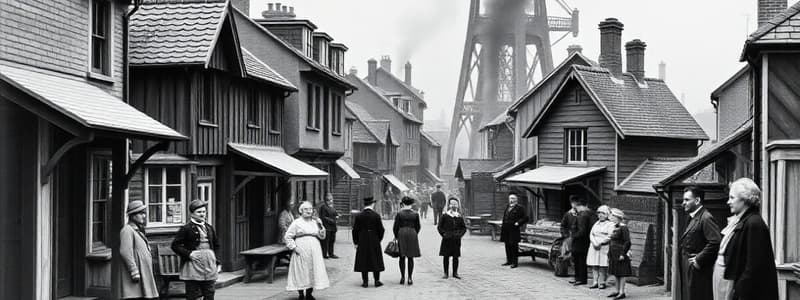Podcast
Questions and Answers
What was a common living arrangement for factory workers in industrial towns during the 18th and 19th centuries?
What was a common living arrangement for factory workers in industrial towns during the 18th and 19th centuries?
- Terraced houses built back-to-back (correct)
- Detached single-family homes
- Houses with large backyards
- Luxury apartments with modern amenities
Which class had the smallest population in the 1700s and 1800s?
Which class had the smallest population in the 1700s and 1800s?
- Upper class (correct)
- Middle class
- Merchant class
- Working class
What factor severely limited educational opportunities for working-class children?
What factor severely limited educational opportunities for working-class children?
- Financial inability to pay for schooling
- Lack of interest in education
- Mandatory early employment in factories (correct)
- Strict government regulations
What was the most significant cause of disease in industrial towns in the 1800s?
What was the most significant cause of disease in industrial towns in the 1800s?
Which of the following diseases was NOT commonly associated with industrial towns in the 1800s?
Which of the following diseases was NOT commonly associated with industrial towns in the 1800s?
Flashcards
Terraced housing
Terraced housing
Houses built in a row, often sharing walls, to save space and cost.
Overcrowding in industrial towns
Overcrowding in industrial towns
Multiple people sharing a single, small room due to limited housing options.
Sanitation problems in industrial towns
Sanitation problems in industrial towns
The lack of sewage systems, garbage collection, or clean water sources in industrial towns, leading to disease.
Social pyramid in 18th and 19th century Britain
Social pyramid in 18th and 19th century Britain
Signup and view all the flashcards
Education and social class in 18th and 19th century Britain
Education and social class in 18th and 19th century Britain
Signup and view all the flashcards
Study Notes
Industrial Town Conditions
- Industrial towns like Sheffield, Manchester, Liverpool, and Birmingham faced severe living conditions.
- Housing was built in cramped terraces, often with houses situated back-to-back.
- Housing was extremely overcrowded, with rooms often housing five or more people.
- Accommodation was rented from landlords or factory owners.
- Lack of sanitation: no rubbish collection, litter bins, street cleaning, sewers, or fresh water.
- Sewage flowed in the streets to the nearby rivers, which often served as the source of water for washing and drinking.
- This led to a high incidence of disease.
- Common diseases included typhoid, tuberculosis, and cholera.
Social Classes
- British society was divided into three broad classes in the 18th and 19th centuries.
- Upper class (approximately 100,000 people).
- Middle class (approximately 2 million people).
- Working class (approximately 15 million people).
- The social structure reflected a pyramid, with the upper class at the top, followed by the middle class and the working class at the bottom.
- This structure had a clear hierarchy with the top class benefiting from a more privileged existence.
Educational Disparities
- Educational opportunities were closely linked to social class.
- Children of the working class often lacked access to formal education until the late 19th century.
- They typically were sent to work or apprenticeships preparing for potential factory work.
- Middle-class children received education from tutors or grammar schools, with potential for college or university to pursue professions like medicine, law, or finance.
- Upper-class children were tutored at home, followed by prestigious private schools and universities aiming toward careers in politics or the clergy.
Studying That Suits You
Use AI to generate personalized quizzes and flashcards to suit your learning preferences.





